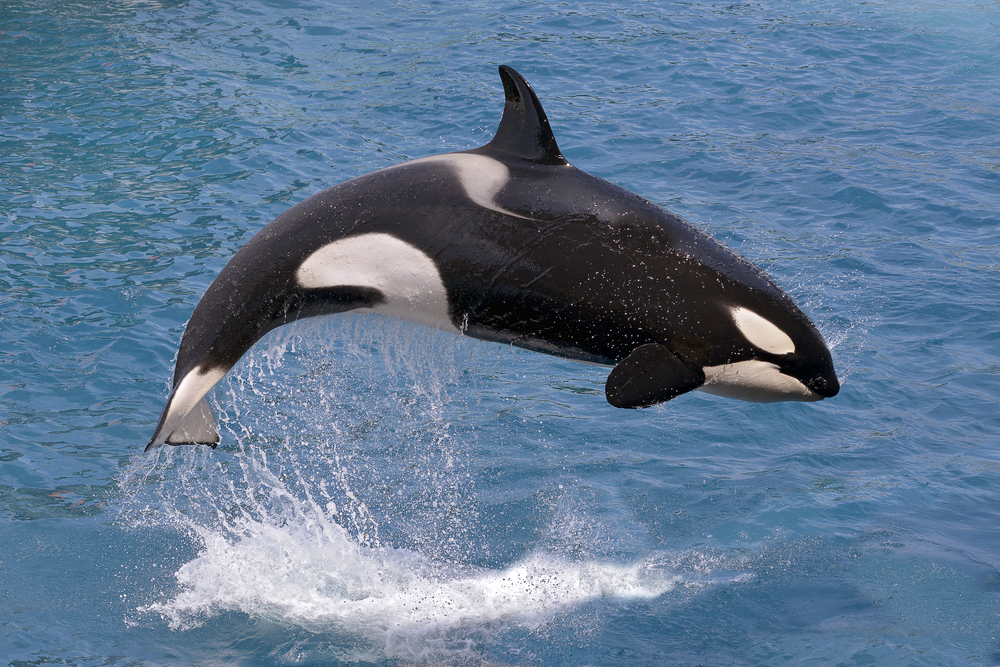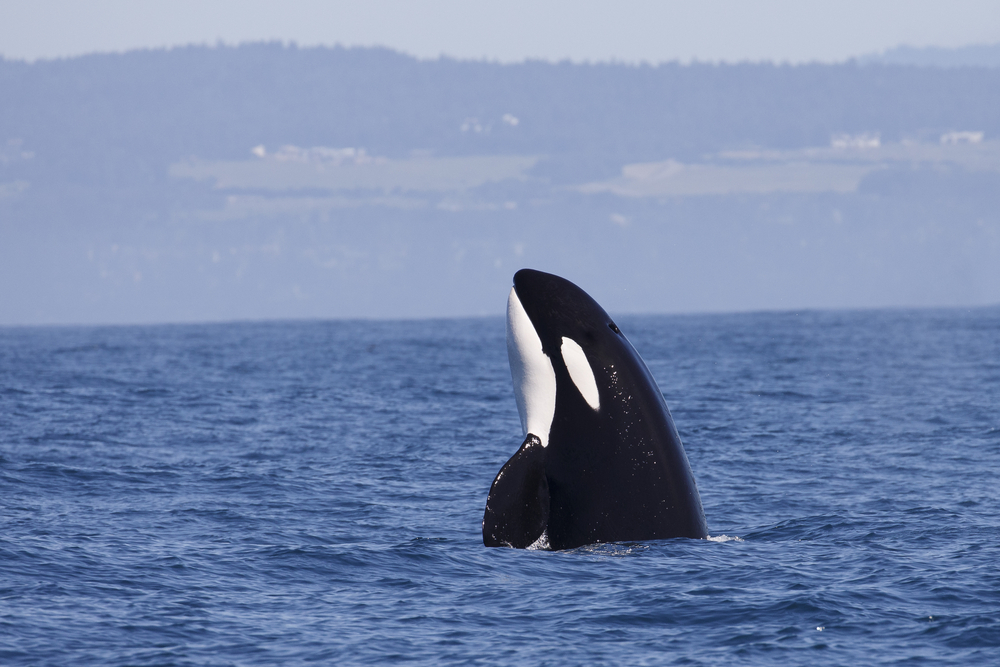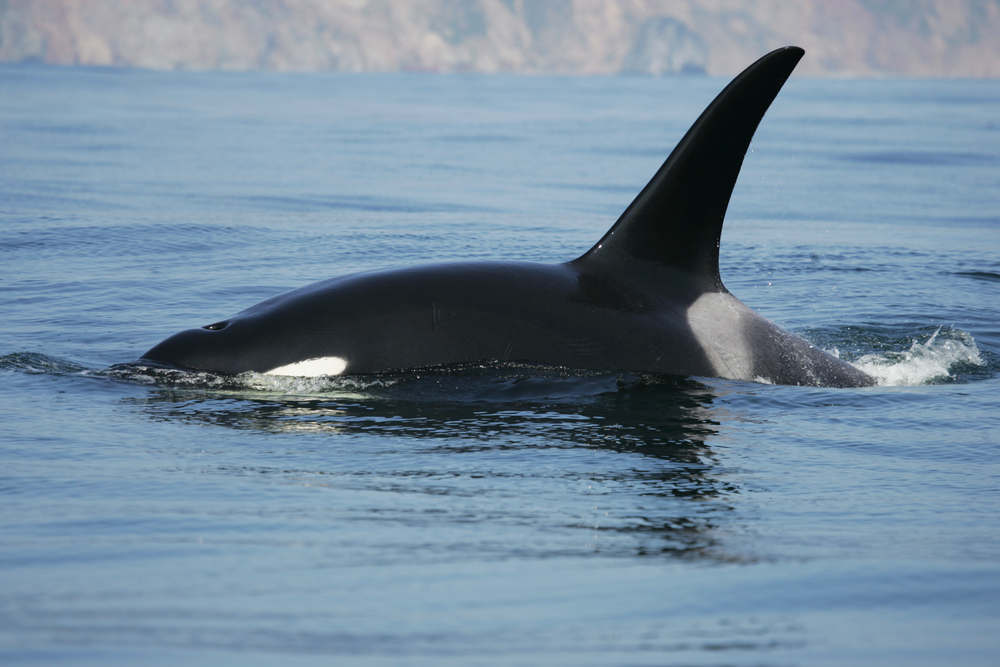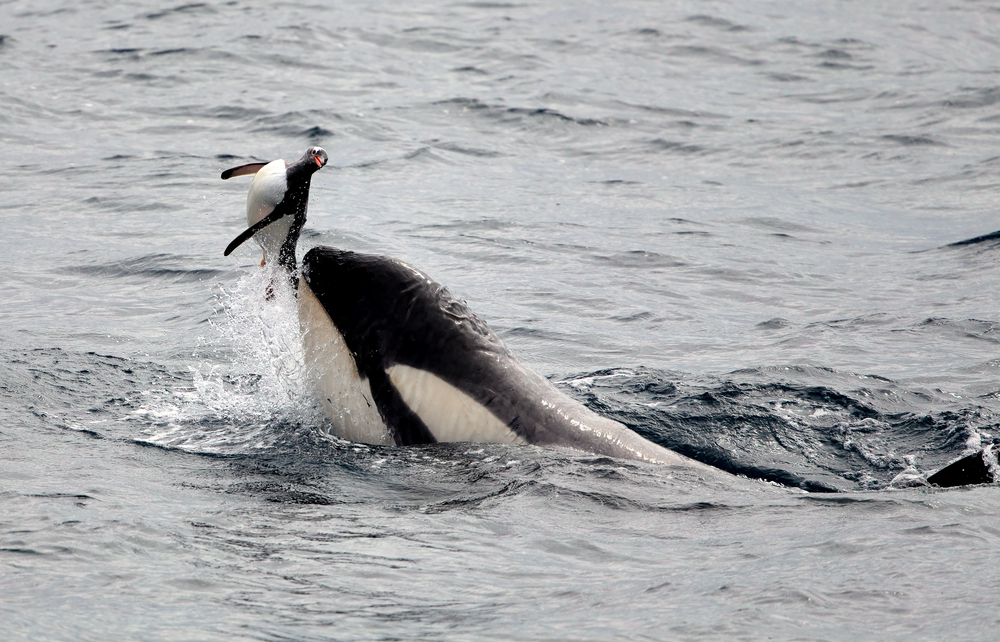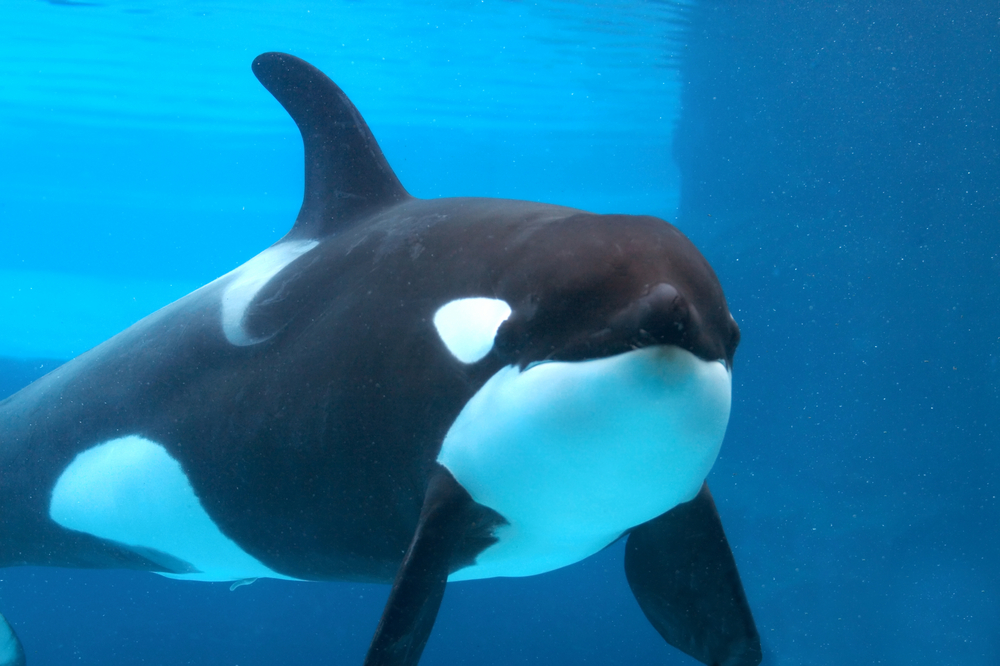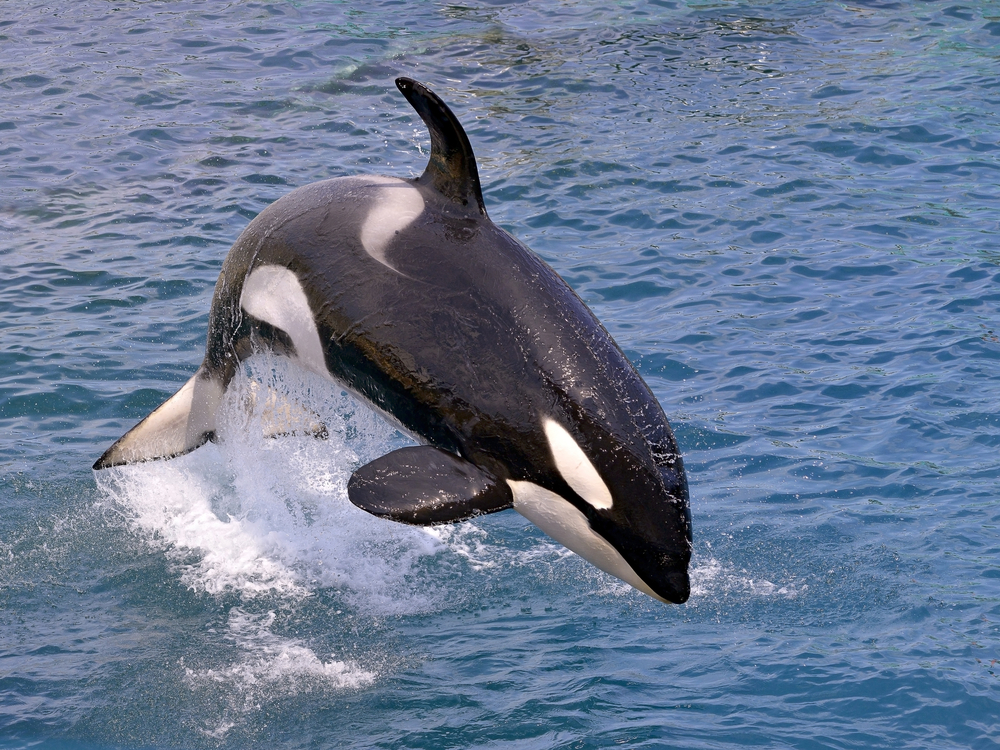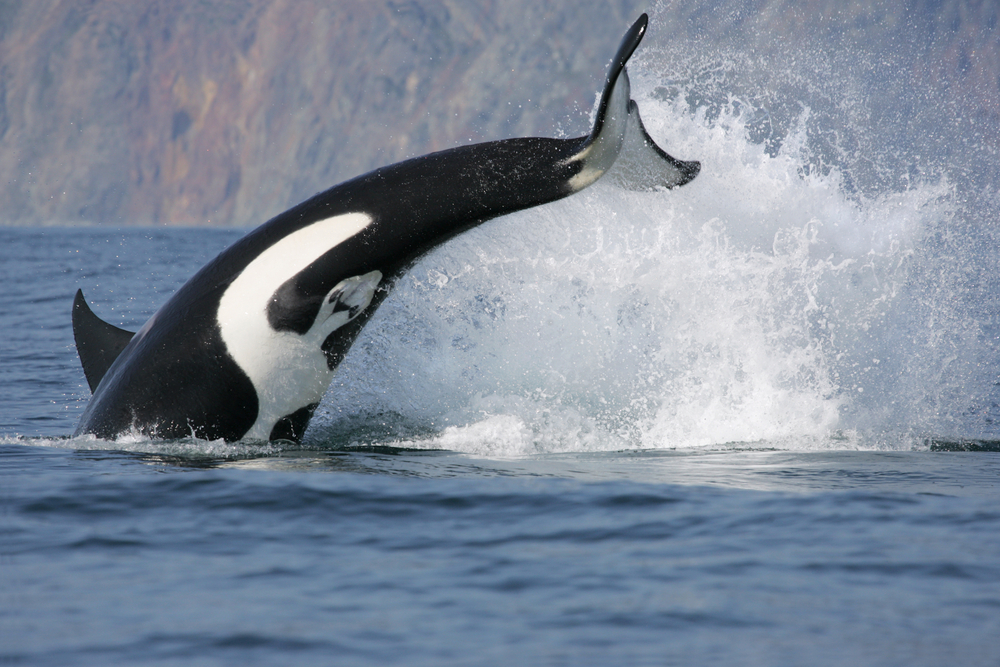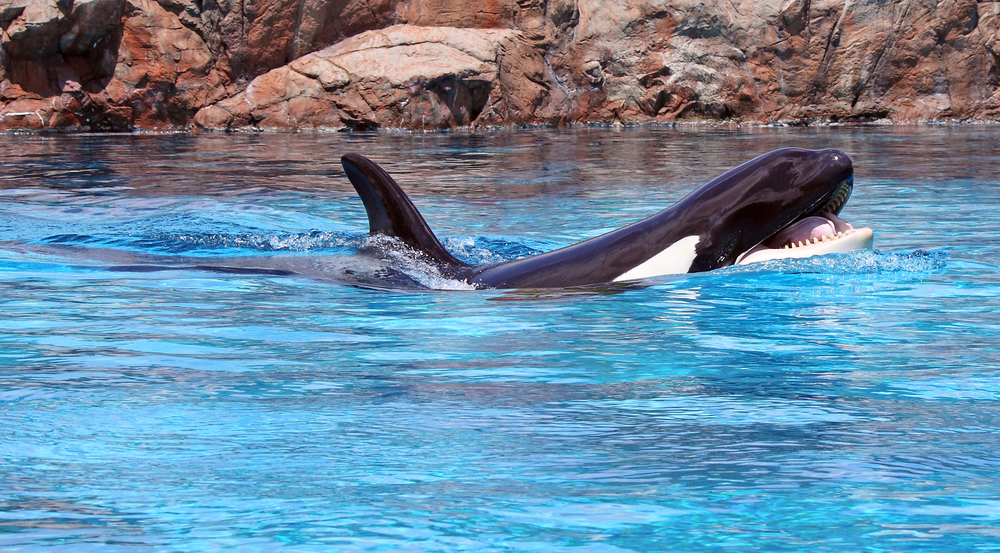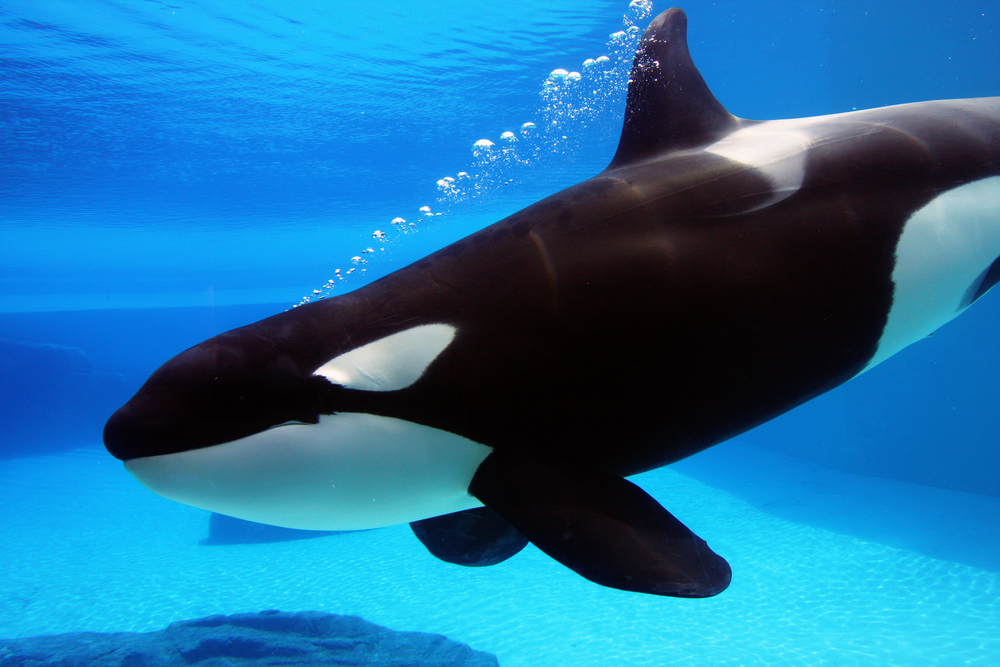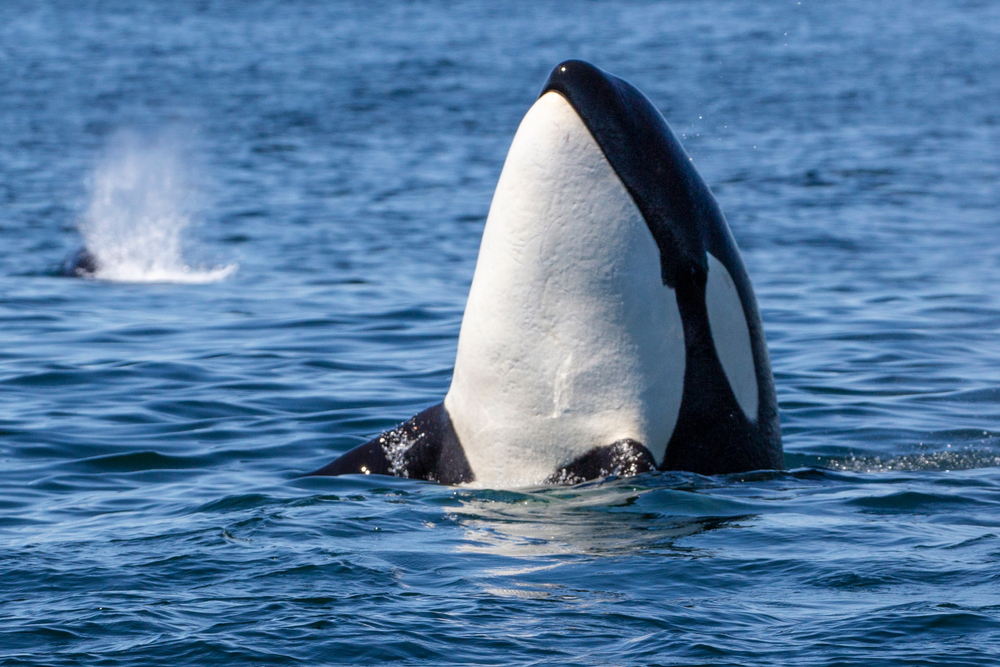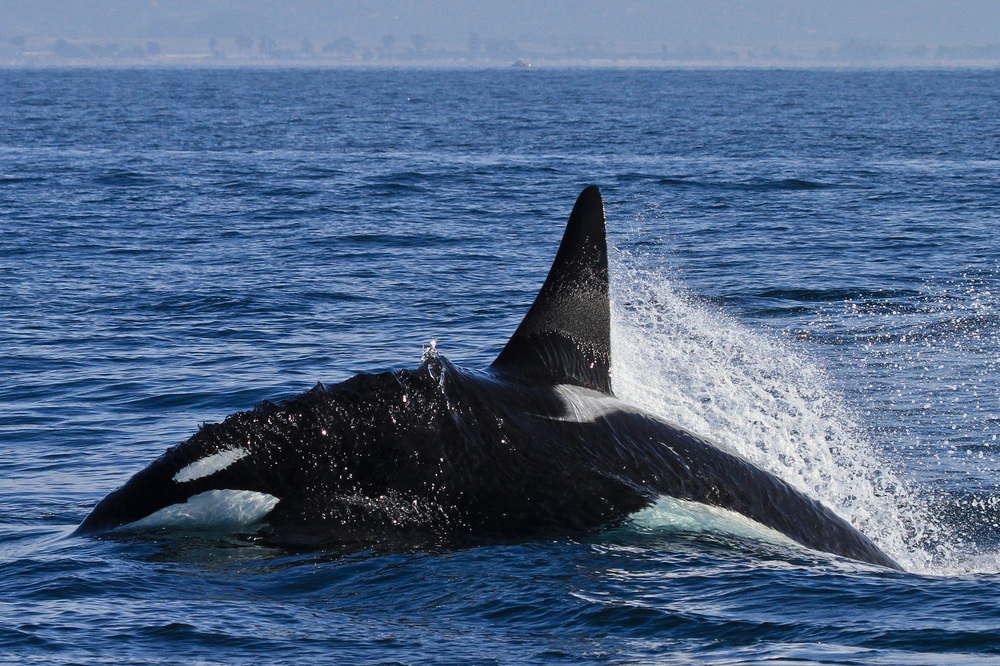The killer whale, or orca, is actually a species of dolphin despite its common name. Despite its size and appearance, it belongs to the dolphin family, Delphinidae.
About
The Killer Whale, scientifically known as Orcinus orca, belongs to the Animal Kingdom’s phylum Chordata, class Mammalia, and order Cetacea, making it a relative of dolphins and porpoises. As the largest member of the dolphin family, Killer Whales are apex predators found in oceans worldwide, from the Arctic to the Antarctic.
Characterized by their distinctive black and white coloration, Killer Whales have sleek, torpedo-shaped bodies that can grow up to 32 feet (10 meters) in length and weigh as much as 6 tons. They possess a prominent dorsal fin, which can reach up to 6 feet (1.8 meters) tall in males, and a sleek, streamlined body ideal for fast swimming. Their powerful tails propel them through the water at speeds of up to 34 miles per hour (56 kilometers per hour).
Killer Whales exhibit complex social structures and are highly intelligent, with sophisticated communication systems and advanced hunting techniques. They live in matrilineal family groups called pods, led by a dominant female known as the matriarch. Pods can consist of up to 40 individuals, including offspring of various ages.
These apex predators have a diverse diet, feeding on fish, squid, marine mammals such as seals and sea lions, and even other whales. Their hunting strategies are highly coordinated, with pods working together to corral and capture prey.
Conservation Concerns
Despite being widespread and relatively abundant in many oceanic regions, Killer Whales face a range of conservation concerns, including habitat degradation, pollution, prey depletion, and human disturbance. Additionally, some populations are threatened by entanglement in fishing gear and collisions with vessels.
The conservation status of Killer Whales varies among different populations and regions. While some populations, such as those in the waters off Norway and the Pacific Northwest of the United States, are considered stable, others, particularly those in the Southern Ocean and parts of the North Atlantic, face greater threats.
Several Killer Whale populations are listed as data deficient, while others are classified as endangered or vulnerable on the IUCN Red List. Conservation efforts focus on habitat protection, reducing human impacts, and implementing measures to mitigate threats such as bycatch and pollution. Continued research and monitoring are essential for understanding and addressing the conservation needs of Killer Whales worldwide
Physical Characteristics
The killer whale, or orca (Orcinus orca), is a highly social and intelligent predator, residing at the top of the marine food chain. Part of the oceanic dolphin family (Delphinidae), they are the largest and one of the most powerful marine mammals. Orcas are found in all oceans, from the Arctic and Antarctic regions to tropical seas. Their physical characteristics, combined with their hunting prowess, make them one of the most recognizable and formidable marine species.
Size
- Body Length: Adult male killer whales typically range from 20 to 26 feet (6 to 8 meters) in length, while females are slightly smaller, ranging from 16 to 23 feet (5 to 7 meters).
- Weight: Males weigh between 8,000 to 12,000 pounds (3,629 to 5,443 kilograms), with some large individuals reaching up to 16,000 pounds (approximately 7,257 kilograms). Females are lighter, with weights ranging from 3,000 to 8,000 pounds (1,361 to 3,629 kilograms).
Physical Characteristics
- Body Shape: Orcas have a robust, streamlined body with a large dorsal fin and a pair of pectoral fins. Their body shape is adapted for speed and maneuverability in water.
- Dorsal Fin: The dorsal fin is a distinguishing feature, particularly in males, where it can grow up to 6 feet (1.8 meters) tall. In females and young orcas, the dorsal fin is smaller and more curved.
- Pectoral Fins: Their pectoral fins are large and rounded, functioning as stabilizers during swimming and maneuvering.
- Tail Flukes: The tail flukes are wide and powerful, contributing to their speed and agility in water. The flukes are horizontal, enabling vertical motion through the water when the animal propels itself by moving the tail up and down.
- Head: The head features a rounded forehead, known as the “melon,” which is used in echolocation. The mouth contains a set of large, sharp teeth, up to 4 inches (10 centimeters) long, designed for grasping and tearing their prey.
- Coloration: Killer whales have a distinctive black and white coloration. The upper side is black, covering most of the body, while the underside is mostly white. They have a white patch above the eye and a grey or white “saddle patch” just behind the dorsal fin.
- Skin Texture: Their skin is smooth, and the black and white pattern is unique to each individual, which helps researchers identify them in the wild.
Killer whales are known for their complex social structures, often living in matrilineal family groups known as pods. Their vocalizations, used for communication and navigation, vary widely between pods and are thought to be culturally learned. The physical and social characteristics of orcas, combined with their widespread presence in marine environments around the world, make them a subject of fascination and study in marine biology
Reproduction
The reproductive cycle of the Killer Whale (Orcinus orca) is characterized by distinct stages crucial for the perpetuation of this apex marine predator:
- Mating and Courtship:
- Orcas do not have a specific breeding season, allowing for mating to occur at any time of the year. Courtship behaviors can include vocalizations, gentle touching, and synchronized swimming among potential mates.
- Gestation:
- The gestation period for killer whales lasts approximately 17 months, a lengthy term that ensures the calf is born well-developed and ready to swim immediately.
- Birth and Maternal Care:
- Killer whales typically give birth to a single calf. Twin births are extremely rare and not well-documented.
- At birth, calves are about 8.5 feet (about 2.6 meters) long and weigh around 400 pounds (approximately 180 kilograms). They are dependent on their mothers for milk and protection.
- Calves nurse for at least 12 months and often remain in close association with their mothers for several years, learning crucial survival and social skills.
- Infant Development:
- The strong bond between the mother and calf facilitates the transmission of knowledge and culture, essential for the calf’s integration into the complex social structure of orca pods.
- Sexual Maturity:
- Female orcas typically reach sexual maturity around 10 to 14 years of age, while males mature later, between 15 to 21 years. However, males often do not become successful breeders until they are older and have attained a higher social status.
Killer whale societies are matriarchal, with offspring, especially males, staying with their mothers for life. This lifelong bond strengthens the social cohesion of the pod and is a unique aspect of the orca social structure. The extended care provided by orca mothers, along with the communal upbringing within the pod, underscores the complexity of killer whale societies and the importance of social bonds in their reproductive cycle.
Lifespan
Killer Whales (Orcinus orca) are remarkable for their longevity, particularly in their natural habitats:
- Lifespan in the Wild:
- Female killer whales can live up to 80 to 90 years, with some reports of individuals surpassing 100 years. Males have a shorter lifespan, typically living up to 50 to 60 years. The longevity of killer whales is one of the longest among cetaceans, reflecting their complex social structures and robust physical nature.
- Lifespan in Captivity:
- In captivity, the lifespan of orcas is significantly reduced, with many individuals living only into their 20s or 30s. The stress of confinement, along with health issues related to captive environments, contributes to their shortened lifespans.
- Biggest Threats:
- Chemical Pollution: Contaminants such as PCBs accumulate in orca bodies, affecting their immune and reproductive systems.
- Prey Depletion: Overfishing reduces the availability of crucial prey species, impacting orca health and survival.
- Ship Strikes and Noise Pollution: Collisions with vessels and underwater noise can cause physical harm and disrupt orca communication and hunting abilities.
- Capture for Captivity: Although less common now, the capture of wild orcas for marine parks has historically impacted certain populations.
- Climate Change: Changes in sea temperatures and ice cover affect the distribution of prey species, altering orca feeding patterns and habitats.
Conservation efforts are crucial for addressing these threats, promoting healthy populations, and ensuring the longevity of killer whales in the wild. International cooperation and protective measures are essential to mitigate the impacts of human activities on orca populations and preserve their role in marine ecosystems
Eating Habits
Killer Whales (Orcinus orca) are apex predators with diverse diets and sophisticated hunting strategies, reflecting their adaptability and intelligence:
- Diet:
- Orcas have a varied diet that can include fish, seals, sea lions, dolphins, sharks, rays, octopuses, and even large whales. The specific diet of an orca pod often depends on their geographical location and can be divided into distinct ecotypes, each specializing in particular types of prey.
- Some populations are known as “fish-eating” orcas, preferring salmon or herring, while others are “mammal-eating,” targeting marine mammals such as seals and other cetaceans.
- Feeding Techniques:
- Killer whales employ complex and coordinated hunting tactics that are often specific to the prey they target. These can include herding fish into tight balls, creating waves to wash seals off ice floes, or working together to encircle and isolate larger prey.
- They are also known for their ability to beach themselves temporarily to catch seals or penguins on shore, a risky but effective strategy.
- Social Learning:
- Hunting techniques and dietary preferences are passed down through generations, indicating a high level of cultural transmission within orca societies. This knowledge transfer is a key aspect of their survival and success as top predators.
- Adaptations for Feeding:
- Orcas have large, powerful teeth suited for gripping and tearing their prey. Their speed and agility in the water, combined with their intelligence, make them formidable hunters.
- Their echolocation ability allows them to locate prey even in murky waters or at great depths.
The dietary habits of killer whales highlight their role as top predators within marine ecosystems. Their diverse diets and complex hunting strategies not only demonstrate their adaptability but also their importance in maintaining the balance of marine life by controlling prey populations.
Uniqueness
The Killer Whale (Orcinus orca) possesses a combination of characteristics that make it one of the most unique and fascinating creatures in the marine world:
- Distinctive Appearance: Orcas are easily recognizable by their striking black and white coloration, with a dark back and a white chest and sides. They also have a white patch above the eye and a distinctive, tall dorsal fin, which is especially prominent in males.
- Intelligence and Social Structure: Killer whales are highly intelligent, with complex social structures. They live in closely knit groups called pods, which are often matrilineal, meaning they are led by older females. Social bonds within these groups are strong, with sophisticated communication methods and social behaviors.
- Diverse Diets and Hunting Techniques: Orcas are apex predators with varied diets that can include fish, seals, and even large whales. They employ a range of innovative and cooperative hunting strategies, such as herding fish into tight balls or creating waves to wash seals off ice floes. These tactics are often passed down through generations, showcasing a form of cultural learning.
- Vocal Communication: Orcas use a wide range of sounds for communication, including clicks, whistles, and pulsed calls. Each pod has its unique dialect, which is thought to reinforce social bonds and facilitate group coordination, especially during hunting.
- Global Distribution: Killer whales can be found in all the world’s oceans, from the Arctic and Antarctic to tropical seas. This wide distribution is a testament to their adaptability to different marine environments.
- Longevity and Maternal Care: Orcas have long lifespans, with females often living up to 80-90 years. They exhibit extensive maternal care, with calves remaining close to their mothers and other pod members for many years, learning essential survival skills.
- Conservation Status and Human Interactions: While not currently listed as endangered, certain orca populations are threatened by pollution, prey depletion, and habitat loss. Their curiosity and occasional interactions with humans, combined with their portrayal in popular media, have made them iconic symbols of marine life conservation.
These unique attributes highlight the killer whale’s significance within the marine ecosystem, underscoring the importance of ongoing conservation efforts to protect these remarkable animals and their habitats.
FAQ’s
1. Is the killer whale more like a dolphin or a whale?
2. How fast does the killer whale (orca) swim?
Killer whales, or orcas, can swim at speeds of up to 34.5 miles per hour (56 kilometers per hour) in short bursts, but they typically cruise at around 3 to 8 miles per hour (5 to 13 kilometers per hour).
3. Do killer whales (orcas) dive like whales?
Yes, killer whales, or orcas, do dive like whales. They are skilled divers and can dive to considerable depths in search of prey. While their dives may not be as deep or as prolonged as some other whale species, they are certainly capable divers.
Sources
- Britannica, Killer Whale, https://www.britannica.com/animal/killer-whale, retrieved February 2024.
- Burnie, David & Wilson, Don, Animal, Smithsonian Institute, Washington DC.
- Clutton-Brock, Juliet and Wilson, Don, Mammals, Smithsonian Handbooks, New York, NY.
- Hickman et al, Integrated Principle of Zoology, McGraw Hill, Boston.






























































